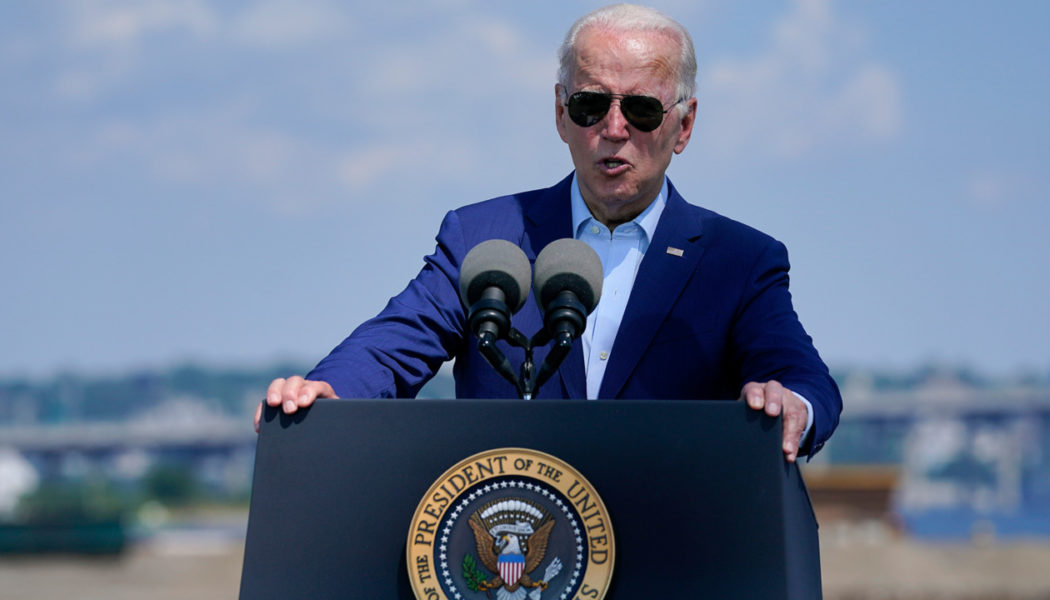
Biden framed the fight against the greenhouse gases that are heating the planet as one of his highest priorities, alongside combating the pandemic.
But those ambitions suffered a major blow last week when Sen. Joe Manchin (D-W.Va.) rejected plans to spend $300 billion to expand clean energy incentives. And last month, the Supreme Court erected legal obstacles to the federal government’s ability to regulate carbon dioxide from power plants, the second largest source of the greenhouse gas.
“As president, I have a responsibility to act with urgency and resolve when our nation faces clear and present danger. And that’s what climate change is about. It is literally, not figuratively, a clear and present danger,” Biden said.
His comments come as more than 100 million Americans swelter under 100-degree temperatures and European nations face record heat. The Western U.S. is suffering from the worst megadrought in 1,200 years, drying up reservoirs and slowing the flow of the Colorado River that supplies water to tens of millions of people.
Biden was visibly sweating as he delivered his speech on a sweltering 90-plus degree afternoon in southeastern Massachusetts, the second day of a heat wave that’s forced communities across the state to open cooling centers for residents and declare heat emergencies. Sen. Elizabeth Warren (D-Mass.) and Rep. Bill Keating (D-Mass.) donned black baseball caps to shield themselves from the beating sun.
As he has since the campaign, Biden sought to frame his climate agenda in terms of spurring job growth in new competitive arenas of the economy. The backdrop for Wednesday’s appearance helped sent that message: Biden spoke facing the site of the shuttered Brayton Point coal power plant that’s being retooled into Massachusetts’ first offshore wind manufacturing facility, a dusty and rocky expanse on the shores of the Taunton River replete with towering power lines and vast warehouses in the process of being repurposed for producing wind energy.
“It’s the perfect location for President Biden to talk about, to focus on climate change, because it’s the former site of a dirty coal-fired power plant that threatened not only the climate but the health of the surrounding community,” Brad Campbell, president of the Conservation Law Foundation, which spearheaded the effort to shut down the old plant, said in an interview.
Biden on Wednesday proposed the first-ever offshore wind energy area across 700,000 acres in the Gulf of Mexico, which the White House said would enable enough new electricity to power 3 million homes. That’s not an entirely new idea: The Interior Department already was assessing portions of the Gulf of Mexico for wind power. Biden also directed Interior to promote offshore wind in the southern- and mid-Atlantic Ocean and Florida’s Gulf of Mexico coastline.
While those steps would help bring renewable power into the grid, Biden is far from reaching his goals of achieving net-zero electricity by 2035. Fossil fuels now supply 60.8 percent of U.S. power, according to the U.S. Energy Information Administration.
Hitting Biden’s zero-carbon goal becomes even harder without the subsidies included in earlier drafts of Democrats’ reconciliation package. Those provisions were the single-greatest factor needed to hit Biden’s broader climate target, an analysis by Senate Majority Leader Chuck Schumer’s office said.
While Manchin was the one who upended Democrats’ legislative agenda, they have also faced steadfast opposition from Republicans who contend that Biden’s plans will damage the U.S. economy — particularly the oil and gas industry that has boomed since the early years of this century. The GOP has also seized on this year’s historic rise in gasoline prices, even though that increase has been tied to a global oil market — and broader inflation trend that is hardly a U.S.-only problem.
Meanwhile, raging wildfires and record heat worsened by climate change is costing lives, denting productivity and destroying property. The White House noted 20 extreme weather and climate-related events inflicted $1 billion of damage or more last year, totaling $145 billion. The Occupational Safety and Health Administration since April has under a new program conducted 564 heat-related inspections to prevent workplace illnesses and deaths.
Yet executive action alone is unlikely to get Biden to his climate goals, which include slashing the nation’s greenhouse gas emissions to half their 2005 levels by the end of this decade. That failure in turn threatens to dampen enthusiasm from the younger and progressive voters that Democrats need in this year’s midterm elections.
Climate activists and some Democratic lawmakers have urged Biden to go far bolder in taking unilateral action — for instance by declaring a climate emergency that would give him broad powers to halt fossil fuel exports, marshal clean energy production and reprogram spending to bolster climate defenses.
“The president has an ability to protect our country when our national security is threatened,” Sen. Ed Markey (D-Mass.) told reporters this week. “And clearly, the climate crisis is a threat to national security.”
He joined eight other senators in a Wednesday letter urging Biden to take such a step.
White House press secretary Karine Jean-Pierre said Tuesday that a climate emergency remains on the table, though no decision is expected on that this week. A senior administration official told reporters in a call Wednesday call that Biden “is going to be very clear that since Congress is not going to act on this emergency, he will,” adding that future steps will come in the coming days and weeks.
“This is an emergency and I will I will look at it that way,” Biden said. “As president, I’ll use my executive powers to combat climate crisis in the absence of congressional action.”
Biden’s allies said they were willing to give the administration space to chart its next course for executive action as it emerges from the rubble of reconciliation, where Manchin’s opposition last week killed efforts to pass clean energy and electric vehicle tax credits through Congress.
“We had all been on Plan A,” said Tiernan Sittenfeld, senior vice president for governmental affairs at the League of Conservation Voters. “It takes a minute to recalibrate.”
Despite the gridlock in Congress, and four years of regulatory rollbacks from the Trump administration, the U.S. is actually on track to meet former President Barack Obama’s goal for cutting greenhouse gas pollution — which called for reducing those emissions to 26 percent below 2005 levels by 2025. However, those reductions aren’t anywhere steep enough to meet what climate scientists say the world needs to avoid the worst effects of climate change from taking root.
“If I were the president I would be asking my staff for a list of all of my authorities, and I would be evaluating all of them for what pieces of this challenge they could solve,” Sen. Martin Heinrich (D-N.M.) told POLITICO.
The White House has notched some prior legislative victories and taken unilateral steps to get closer to those goals. It’s already distributing billions of dollars for clean energy demonstration and electric transportation from the $1.2 trillion infrastructure law, paused tariffs that raised costs on imported solar equipment and set a government-wide requirement to achieve net-zero emissions by 2050 for all electricity it purchases, contracts and other services.
Biden announced two other steps Wednesday that the White House said reflected an increased willingness to go it alone on climate: It issued new guidance for a program that would allow low-income residents to more easily purchase efficient air conditioners and announced $2.3 billion for a Federal Emergency Management Agency program that helps communities bolster defenses against the effects of climate change.
But climate hawks have been dismayed by Biden’s reluctance to use executive powers to date. Biden came into office having to repair federal agencies that fractured under former President Donald Trump, who actively antagonized climate activists. Restocking the bureaucracy at key agencies like EPA have led to slower than desired progress on crafting regulations, government officials said, but the administration now has several rules in the queue for the coming year.
“There’s a lot, lot, lot left to be done,” Sen. Sheldon Whitehouse (D-R.I.) told reporters Monday.
Josh Siegel and Lisa Kashinsky contributed to this report.
[flexi-common-toolbar] [flexi-form class=”flexi_form_style” title=”Submit to Flexi” name=”my_form” ajax=”true”][flexi-form-tag type=”post_title” class=”fl-input” title=”Title” value=”” required=”true”][flexi-form-tag type=”category” title=”Select category”][flexi-form-tag type=”tag” title=”Insert tag”][flexi-form-tag type=”article” class=”fl-textarea” title=”Description” ][flexi-form-tag type=”file” title=”Select file” required=”true”][flexi-form-tag type=”submit” name=”submit” value=”Submit Now”] [/flexi-form]









